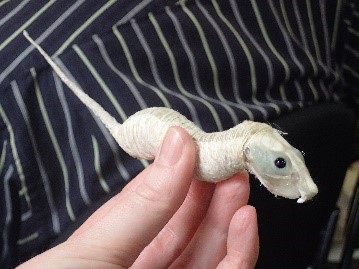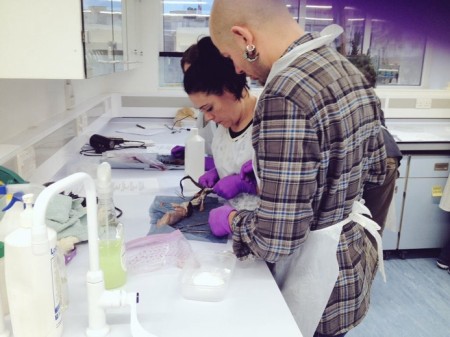Name: Jack Ashby
What is your role on the NatSCA committee?
I tend to have more of a focus on matters relating to audiences and communication, but to be honest as an “Ordinary Member” of Committee I really enjoy getting involved in every aspect that I feel I can be useful in. Working in a small museum means I have a fairly broad experience across the different kinds of work our members might be involved in, from collections management, media and learning (which is where I started my career) to strategic direction. NatSCA is doing loads of great stuff at the moment – it’s nice to have such a range of projects to feed in to.
Job Title & Institution: Manager of the Grant Museum of Zoology, UCL
Twitter username: @JackDAshby

Tell us about your day job:
I have strategic overview of all our varied activities – developing the Grant Museum as both a valuable academic resource and an excellent public venue, while caring for our collections responsibly. A big part of my job is to develop and oversee ways for the museum to become a gateway for between the public and academia (I take the lead on exhibitions and most public-facing research projects, while the fantastic learning staff focus on events), and find opportunities to integrate the collection into more university courses. I’m responsible for our finances and income generation, staff management, interpretation, venue and marketing. I also spend a fait bit of time trying to ensure that we are having an impact on the museum and university sectors. I don’t really know how to describe a normal day.
Natural science collections are very popular with museum visitors. Why do you think this is?
Natural science are easy to interpret and they’re visually striking. There are far lower barriers to access – the level of knowledge even the least engaged visitor walks down the street with is more than enough to get something out of a museum visit. Unlike some other disciplines, which often expect and require their visitors to know things that aren’t easy to acquire (while not always doing enough to help them acquire that understanding), natural history is everywhere. Even if they don’t recognise a specimen instantly, in many cases all we have to do is say “that’s a rhino”, and the visitors have all they need themselves to make some meaning from what they see.
And also a lot of our stuff looks weird.
What do you think are the biggest challenges facing natural science collections right now?
Sadly, challenges often comes from within the museum sector, or at least those close to it, like governing bodies. No sector has it rosy at the moment and it’s critical we work together and learn from each other. I think often if the individuals who are making the decisions aren’t sympathetic to the value of our collections, we can suffer from their inability to see the value of our work. Perhaps because natural history is so easily accessible, it can be easy to write us off as “just for kids”. Conversely, the disciplines that could be seen as being more elite or grown-up can somehow be viewed as more valuable. We can also (unfairly) be tarred with the “old-fashion” brush. This is often a result of under-investment in refreshing our galleries, which becomes a self-fulfilling prophecy. It’s so frustrating as we have demonstrated time again that natural science collections are far-and-away the most popular among visitors, and also arguably the discipline that has the most potential to change the world through our roles research around genuinely global challenges like climate change and biodiversity loss.
What do you love most about working with natural science collections?
So much. Seeing how every lump and bump on a specimen translates into how that animal survived in its habitat always gets me going.
It’s a delight to work in a sector that gives people opportunities to get genuinely excited about the natural world. My office sits directly above the Micrarium in the Grant Museum. Every time I hear someone say “Wow!” I smile.
#CheesyButTrue
What would your career be in an alternate universe without museums?
I spend a couple of months a year as a kind of expert volunteer on fieldwork in Australia, trapping small mammals, reptiles and frogs with wildlife NGOs and universities with conservation agendas. It’s probably an even more competitive field that the museum sector, but I could see myself doing that full time if museums didn’t exist.
What is your favourite museum, and why? (It can be anywhere in the world, and doesn’t have to be natural science-related!)
Am I allowed two? The Biologiska Museet in Stockholm makes me very happy every time I go out there, for a reason I can’t really explain as it’s impossibly old-fashioned. It’s a single wooden building from the 1890s with one huge diorama running around the inside of the whole building (it’s more or less the only thing in there), over two stories high. You go up a wrought iron staircase through the middle. As you walk round the wall, each of the Nordic biomes are represented with all their animals in an original diorama setting. There’s no interpretation except for a type-written piece of paper with a list of every species (hundreds) visible from each numbered pane of glass.
Also in contention is the Captain Cook Memorial Museum in Whitby. It’s an amazing example of how professional a volunteer-run museum can be, and I just love age of exploration and voyages of discovery. I was working with them on a big partnership project over the last couple of years and it’s been an absolute pleasure. I’ve learnt a lot.






















